The Measure of Mario pt.2
 Sunday, November 22, 2009 at 10:56PM
Sunday, November 22, 2009 at 10:56PM New Super Mario Brothers was criticised by many for being more of the same familiar Mario gameplay we've experienced for years. In other words, the game wasn't new or original enough. When these critics are pressed for more specifics, they make a general statement like "NSMB is more like SMB than SMB3 or SMW." Since its release in 2006, I haven't found anyone who could articulate exactly how NSMB isn't as creative and original as the other Mario games. At best, I get a recap of the critic's feelings.
Intuition is great. And feelings can be excellent tools for processing data very quickly. However, it takes real analysis and a clear, exacting critical-language to articulate how a game like NSMB's level design compares to the any other 2D Mario platformer. Figuring out just how "new" NSMB is takes research. I've done the work and have assembled everything that we need. Before we can compare the games, we must break down the level design of each Mario game and identify trends.
To begin we must understand that level design is a very broad term. So, we must break it down into smaller parts. A given 2D Mario platforming level is made up of these parts...
- structures
- gameplay ideas
- enemies
- coins
- layers
- secrets
STRUCTURES
Though all the Maio levels are composed of bricks and tiled objects, each game's levels as a whole have unique themes, shapes, and patterns to their structures. The varying trends are mostly likely due to the evolution of Mario's mechanics as well as the increase in technology, experience, and creativity of the developers. Understanding how the structures and the space around the structures shapes gameplay is the first step to understanding Mario's level design.


- Hard edged design. The actual interactive platforms and structures have crisp edges to them. Whether a structure is composed of brick, pipe, or sea floor, the overall look is one of order, function, and execution
- Flat surfaces. Every solid surface you can stand on is a flat one. There are no swinging ropes, slanted surfaces, or swooping platforms.
- Solid structures. Every platform in the game is a solid surface. More specifcally, you can't JUMP up through the bottom and land on the top.
- Symmetric vs asymmetric structures. Most of the overworld and castle structures are arranged symmetrically to communicate a sense of being man made. The asymmetric elements in the underground levels and mushroom top levels communicate a more haphazard, organic design.
- Everything fits within the screen view. Due to the limitations of the NES, SMB's level structures are limited to fit on the screen. If you pay close attention, you can even see fireballs loop from the left side of the screen to the right, or Mario snag a 1up Mushroom at the bottom of the screen by JUMPing up at the very top of the screen.
- 6 brick pits. The largest pit in the game is only 6 bricks wide. This size pit can be cleared with a bit of room to spare from a RUN-JUMP.

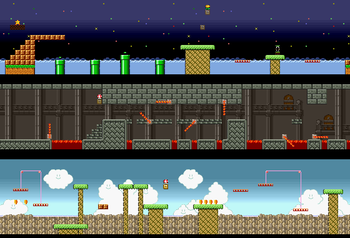
- Building off of the same art assets from SMB, this game shares the same look and feel to its structures.
- Wider pits. This game takes the SMB conventions and pushes many of them further. Many pits in this game are much wider than 6 bricks wide. Based on the way the screen scrolls with the player, for some of these pits you can't see where you need to land before you JUMP off the edge. Also, instead of providing a platform to land on, sometimes there's a lone ParaKoopa flying in the sky that players must JUMP off of to survive. Instead of being able to look before you leap, players must be willing to just trust the game or throw their caution into the wind.
- More pits. One of the most dangerous elements in a Mario game (without a wall jump of course), the multitude of pits in this game increase the challenge.
- Smaller footholds. Higher jumps. And closer quarters. Everything necessary for maneuverability or progression has been set just a little further away from player's reach. Not only do you have to JUMP higher for platforms but there even less room to RUN/JUMP off of and less room to land on. Structures at times are arranged uncomfortably close limiting Mario's JUMPing abilities and forcing players to fight for every brick of space. You'll often find yourself thinking, "Why did they put that THERE?! That's going to make things really hard!" That's the point.

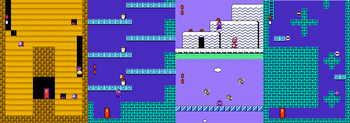
- Though using brand new art assets, this game maintains the ridged blocky design of its predecessors.
- Quantified look. Sloppy feel. For the most part, the brick based, quantified structures in SMB2 work fine. Unfortunately, there are many cases when it looks like Mario (or any other playable character) can duck under and attack or squeeze through a hole but are unable to. Everything should fit tightly together like SMB. But it just doesn't.
- 1-way platforms. This special kind of platform is one where players can JUMP up through the bottom of and land firmly on top. Furthermore, for Mario games that use these kind of platforms, there is no way to jump back down. Most of the platforms in this game are 1-way platforms. SMB2 also features layered one way platforms (see row 1 scene 3 in image above).
- Structures are taller. Compared to SMB and SMB:LL the structures in SB2 are taller. This is probably due to the SUPERJUMP mechanic and that levels scroll vertically.
- Vertical and horizontal progression. Before, players could only progress by moving right. Now players may have to move right, up, down, or left.
- Free scrolling. Unlike in previous Mario games, now the player is free to back track instead of being stopped by an invisible wall. Players can also travel up and down ladders and scroll back and froth vertically in many areas.
- More inorganic structure arrangement. Most of this game is made of long areas the player must progress through. The platforms and other structures in these areas are arranged in a way that's reminiscent of early NES design. Like Kid Icarus or some Bubble Bobble levels, the platforms are at times arranged without a refining trend. In other words, the lengthy challenges don't get any more interesting or difficult. The lack of a trend in turn communicates a lack of design, which gives these sections an inorganic feel. It's as if the levels were randomly generated.

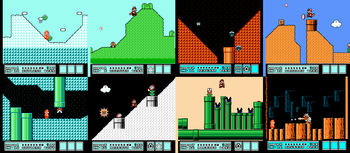
- Hills and undulations. With new slanted surfaces more organic shapes were incorporated. Now Mario can JUMP up hills and slide down the other side. The hills not only make the game look more organic and play more fluidly (due to the SLIDE mechanic), they also allowed the developers to create environments that weren't just a series of vertical or horizontal hallways/shafts. Furthermore, bumps were designed into many flat surfaces to break things up and distinguish the look and feel of the game from its predecessors.

- Structures that move. Not only can platforms move in new ways, but large structures can move as well. Spiked ceilings can fall. Platforms can follow paths through the sky. And airships can sway.
- Levels that move you. The auto scrolling level was pioneered for the Mario series in this game. Though the player can only progress as quickly as the screen scrolls there are always platforms to jump to, enemies to dodge, and/or secrets to find making the entire trip quite eventful.

- Wet dry areas. Before, players could only swim through an entire level of water. Now, it comes in small troughs, shallow shores, rising tides, and small pools.

- A balance of 1-way platforms to solid platforms. Falling somewhere between SMB (no 1-way platforms) and SMB2 (almost all 1-way platforms) SMB3 creates a nice balance between the two. For compact areas, several 1-way paltforms are pushed closely together. For everything else, SMB3 features solid structures.
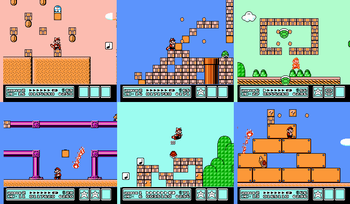
- Playgrounds of gameplay. This is the most zoomed in Mario game ever with a screen size of 10 bricks tall (The port to GBA reduces the screen size even further!). The size of the screen for NSMBWii is 15 bricks tall. SMB2 14 bricks tall. SMB 13 bricks tall. NSMB (DS) 11 bricks tall. With less room for on screen objects, the developers designed each level with "playgrounds" of concentrated gameplay. Instead of simply JUMPing over a pipe and moving on (perhaps after checking if you could enter it), SMB3 puts you on top of a small brick castle and gives you a Koopa to kick inside. After many of the bricks have be knocked away you're free to journey into the modified playground and discover secrets. Instead of spacing out the platforming challenges, enemy sections, and secrets, SMB3 tends to merge them all together.
- Bite sizes levels. The compressed ultra tight design of each level in turn makes each level very short. If you race through, which is something that's not hard, you may wonder what was so special about a level. At least this leaves more to be discovered when you return.
- Several new types of platforms/structures.


- Wide open spaces vs. narrow hallways. The levels in this game are either designed with lots of open/empty space (mainly on the top half of the screen) or constricting hallways.
- Maze like areas. From caves to water levels, several areas are a series of interconnected small hallways with holes cut between them.
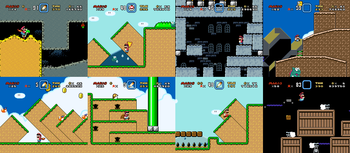
- Varied Shapes and Contrasting Lines. Contrast is created from varying the same shape or juxtaposing diagonal lines with straight lines. This is the governing artistic direction of the structures.
- Medium use of 1-way platforms. Like in SMB3 some platform arrangements are very compact. To make these sections more playable, 1-way platforms are used. Because the levels in SMW stack more shapes/platforms in a given space, more 1-way platforms are used.

- Inorganic design. Some structures are arranged in a random, hodgepodge way as if the level elements were sprinkled into the game. Compared to the clean, ordered look of SMB and SMB3, these sections look unpolished. Many user created SMW levels have similar arrangements.

- Slow Coaster Ride. Unlike the SMB3 levels that scroll automatically, some SMW levels feature scrolling or timed elements that limit or slow player progression. In these sections, the player spends the majority of the time waiting around for the platform to move forward, screen to scroll, or the platforms to open a path.
- Several new types of platforms/structures.


- NSMB borrows a lot of its structural design from SMB (flat, bricky areas), SMB3 (moving platforms/levels, playgrounds, and hills), and SMW (constricting areas, 1-way platforms, moving platforms). It also builds on the design in two distinct ways.
- Tight spaces. Due to the small DS screen and the wall kick ability, many sections in NSMB put players into very tight spaces.

- Many moving platforms. So many platforms and surfaces move in dynamic ways. Some dance to the music. Others are living creatures. And others still respond to Mario's position.
- Several new types of platforms/structures.


- The structural design of NSMBWii is the console extension of NSMB. However, its design distinguishes itself with one trend.
- Large spaces filled with large dynamic platforms. From giant wheels to large swinging platforms, this game is filled with large dynamic platforms.
- Several new types of platforms/structures.
Next up, we look at game ideas; they're the creative conceit of a level.
 Platformer,
Platformer,  Super Mario Bros. in
Super Mario Bros. in  Counterpoint,
Counterpoint,  Genre,
Genre,  Level Design |
Level Design |  Permalink |
Permalink |  Print Article
Print Article 

Reader Comments (5)
/me a bit disapointed to see NSMB and NSMBw "rushed off" after such a accurate review of SMBx and SMW :/
@ sylvainulg
NSMB and NSMBWii are designed with structures and spaces that have already been well established in the previous Mario games. The Jump from SMB to SMB3/SMW was the biggest one for structures so their descriptions were longer than NSMB/NSMBWii.
Yet, you pictured them properly in the snapshot: the shooting pipes, the platforms that not only move, but also rotate at various speeds, (are they similar to the "spinning" platforms. I cannot tell for the Wii version as i haven't tried it yet.
But true, I admit NSMB is mostly "collecting good ideas in a single package" rather than bringing in innovative ideas. I don't remember of a set of platforms that advance by "rolling on gravity" in SMB3 or SMW, but i'm pretty sure it was already in Yoshi's Island, for instance.
Hacker Retrobrad created a handheld console that displays Super Mario Brother in a very special way: each sprite is reduced to one pixel. The console, called Super Pixel Brothers, includes all 20 levels as well boss fights.
@ Plumbing
Neat. I think I've heard of it. I may have to look into more later.